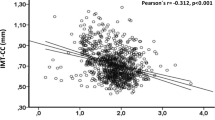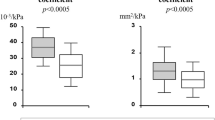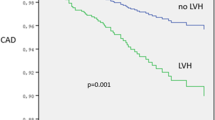Abstract
Serum salusin-alpha, is decreased in essential hypertension and acute coronary syndrome. The study is aimed to explore whether serum salusin-alpha is associated with atherosclerosis and left ventricular (LV) diastolic dysfunction in essential hypertension. Echocardiography, carotid ultrasonography, brachial-ankle pulse wave velocity (BaPWV) and serum salusin-alpha levels were determined in 60 hypertensive patients (29 with and 31 without carotid plaque) and 30 normotensive controls. Hypertensive patients with plaque, compared with those without plaque or the controls, had the lowest values of salusin-alpha. Then the hypertensive patients were divided into left ventricular hypertrophy (LVH) and non-LVH groups according to the echocardiography. Similarly, hypertensive patients with LVH showed the lowest serum salusin-alpha levels. In all subjects, serum salusin-alpha levels were negatively correlated with carotid mean-intima-media thickness (IMT), BaPWV, left ventricle mass index (LVMI) and E/E′ (r=−0.488, P<0.001; r=−0.381, P<0.001; r=−0.294, P=0.006; r=−0.303, P=0.005; respectively). Serum salusin-alpha levels were independent predictors of BaPWV, carotid strain, carotid distensibility, mean-IMT, LVMI and E′/A′ (β=−0.399, 0.283, 0.237, −0.346, −0.306, 0.469; P=0.002, 0.031, 0.016, 0.005, 0.012 and 0.001, respectively) in multiple linear regression models. These results suggest that serum salusin-alpha may be associated with atherosclerosis and LV diastolic dysfunction in essential hypertension.
This is a preview of subscription content, access via your institution
Access options
Subscribe to this journal
Receive 12 digital issues and online access to articles
$119.00 per year
only $9.92 per issue
Buy this article
- Purchase on Springer Link
- Instant access to full article PDF
Prices may be subject to local taxes which are calculated during checkout
Similar content being viewed by others
References
Laurent S, Cockcroft J, Van Bortel L, Boutouyrie P, Giannattasio C, Hayoz D et al. Expert consensus document on arterial stiffness: methodological issues and clinical applications. Eur Heart J 2006; 27: 2588–2605.
Cruickshank K, Riste L, Anderson SG, Wright JS, Dunn G, Gosling RG . Aortic pulse-wave velocity and its relationship to mortality in diabetes and glucose intolerance: an integrated index of vascular function? Circulation 2002; 106: 2085–2090.
Masugata H, Senda S, Yoshikawa K, Yoshihara Y, Daikuhara H, Ayada Y et al. Relationships between echocardiographic findings, pulse wave velocity, and carotid atherosclerosis in type 2 diabetic patients. Hypertens Res 2005; 28: 965–971.
Chahal N, Lim TK, Melderis S, Jain P, Chambers JC, Kooner JS . Increased carotid artery plaque burden is associated with reduced systolic left ventricular function and increased filling pressure in asymptomatic individuals. (Abstract) Heart 2010; 96: A65–A66.
Schillaci G, Pasqualini L, Verdecchia P, Vaudo G, Marchesi S, Porcellati C et al. Prognostic significance of left ventricular diastolic dysfunction in essential hypertension. J Am Coll Cardiol 2002; 39: 2005–2011.
Aurigemma GP, Gottdiener JS, Shemanski L, Gardin J, Kitzman D . Predictive value of systolic and diastolic function for incident congestive heart failure in the elderly: the cardiovascular health study. J Am Coll Cardiol 2001; 37: 1042–1048.
Shichiri M, Ishimaru S, Ota T, Nishikawa T, Isogai T, Hirata Y . Salusins: newly identified bioactive peptides with hemodynamic and mitogenic activities. Nat Med 2003; 9: 1166–1172.
Watanabe T, Nishio K, Kanome T, Matsuyama TA, Koba S, Sakai T et al. Impact of salusin-alpha and -beta on human macrophage foam cell formation and coronary atherosclerosis. Circulation 2008; 117: 638–648.
Watanabe T, Suguro T, Sato K, Koyama T, Nagashima M, Kodate S et al. Serum salusin-alpha levels are decreased and correlated negatively with carotid atherosclerosis in essential hypertensive patients. Hypertens Res 2008; 31: 463–468.
Suguro T, Watanabe T, Ban Y, Kodate S, Misaki A, Hirano T et al. Increased human urotensin II levels are correlated with carotid atherosclerosis in essential hypertension. Am J Hypertens 2007; 20: 211–217.
Tomiyama H, Nishikawa E, Abe M, Nakagawa K, Fujiwara M, Yamamoto A et al. Carotid arterial distensibility is an important determinant of improvement in autonomic balance after successful coronary angioplasty. J Hypertens 2000; 18: 1621–1628.
Arnett DK, Chambless LE, Kim H, Evans GW, Riley W . Variability in ultrasonic measurements of arterial stiffness in the Atherosclerosis Risk in Communities study. Ultrasound Med Biol 1999; 25: 175–180.
Watanabe S, Okura T, Kitami Y, Hiwada K . Carotid hemodynamic alterations in hypertensive patients with insulin resistance. Am J Hypertens 2002; 15: 851–856.
Salles GF, Fiszman R, Cardoso CRL, Muxfeldt ES . Relation of left ventricular hypertrophy with systemic inflammation and endothelial damage in resistant hypertension. Hypertension 2007; 50: 723–728.
Yamashina A, Tomiyama H, Takeda K, Tsuda H, Arai T, Hirose K et al. Validity, reproducibility, and clinical significance of noninvasive brachial-ankle pulse wave velocity measurement. Hypertens Res 2002; 25: 359–364.
Lacolley P, Challande P, Osborne-Pellegrin M, Regnault V . Genetics and pathophysiology of arterial stiffness. Cardiovasc Res 2009; 81: 637–648.
Laurent S, Boutouyrie P, Asmar R, Gautier I, Laloux B, Guize L et al. Aortic stiffness is an independent predictor of all-cause and cardiovascular mortality in hypertensive patients. Hypertension 2001; 37: 1236–1241.
Van Popele NM, Grobbee DE, Bots ML, Asmar R, Topouchian J, Reneman RS et al. Association between arterial stiffness and atherosclerosis: the Rotterdam Study. Stroke 2001; 32: 454–460.
Sugawara J, Hayashi K, Yokoi T, Cortez-Cooper MY, DeVan AE, Anton MA et al. Brachial-ankle pulse wave velocity: an index of central arterial stiffness? J Hum Hypertens 2005; 19: 401–406.
Grobbee DE, Bots ML . Carotid artery intima-media thickness as an indicator of generalized atherosclerosis. J Intern Med 1994; 236: 567–573.
O′Leary DH, Polak JF, Kronmal RA, Manolio TA, Burke GL, Wolfson SK Jr . Carotid-artery intima and media thickness as a risk factor for myocardial infarction and stroke in older adults. Cardiovascular Health Study Collaborative Research Group. N Engl J Med 1999; 340: 14–22.
Wang M, Yip G, Yu CM, Zhang Q, Zhang Y, Tse D et al. Independent and incremental prognostic value of early mitral annulus velocity in patients with impaired left ventricular systolic function. J Am Coll Cardiol 2005; 45: 272–277.
Chahal NS, Lim TK, Jain P, Chambers JC, Kooner JS, Senior R . The distinct relationships of carotid plaque disease and carotid intima-media thickness with left ventricular function. J Am Soc Echocardiogr 2010; 23: 1303–1309.
Chahal NS, Lim TK, Meldris S, Jain P, Chambers JC, Kooner JS et al. Increased carotid artery plaque burden is associated with reduced left ventricular function in asymptomatic individuals. (Abstract) Circulation 2009; 120: S377.
Hillis GS, Møller JE, Pellikka PA, Gersh BJ, Wright RS, Ommen SR et al. Noninvasive estimation of left ventricular filling pressure by E/E′ is a powerful predictor of survival after acute myocardial infarction. J Am Coll Cardiol 2004; 43: 360–367.
Mottram PM, Haluska BA, Leano R, Carlier S, Case C, Marwick TH . Relation of arterial stiffness to diastolic dysfunction in hypertensive heart disease. Heart 2005; 91: 1551–1556.
Acknowledgements
This work was supported by grants from the Natural Science Foundation of Shandong Province (ZR2009CM026), the Department of Science and Technology of Shandong Province (No. 2006GG2202006), independent innovation fund of Shandong university (2009DX004), the National Natural Science Foundation of China (81070076, 30871038), and the National Basic Research Program of China (973 Program, Grant No.:2010CB732605).
Author information
Authors and Affiliations
Corresponding author
Ethics declarations
Competing interests
The authors declare no conflict of interest.
Rights and permissions
About this article
Cite this article
Ti, Y., Wang, F., Wang, Zh. et al. Associations of serum salusin-alpha levels with atherosclerosis and left ventricular diastolic dysfunction in essential hypertension. J Hum Hypertens 26, 603–609 (2012). https://doi.org/10.1038/jhh.2011.71
Received:
Revised:
Accepted:
Published:
Issue Date:
DOI: https://doi.org/10.1038/jhh.2011.71
Keywords
This article is cited by
-
The role of serum salusin alpha and beta levels and atherosclerotic risk factors in idiopathic sudden hearing loss pathogenesis
European Archives of Oto-Rhino-Laryngology (2022)
-
Is the serum level of salusin-β associated with hypertension and atherosclerosis in the pediatric population?
Pediatric Nephrology (2015)



